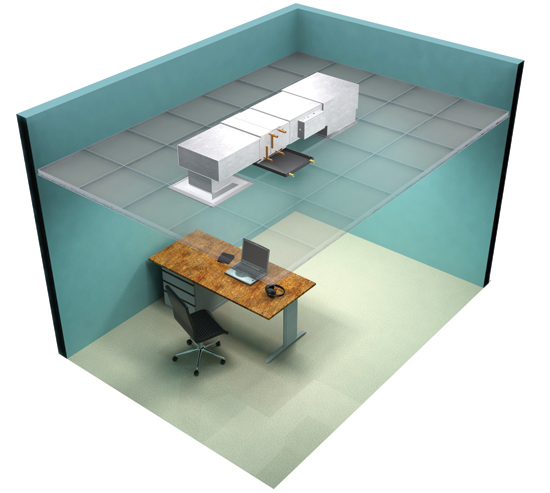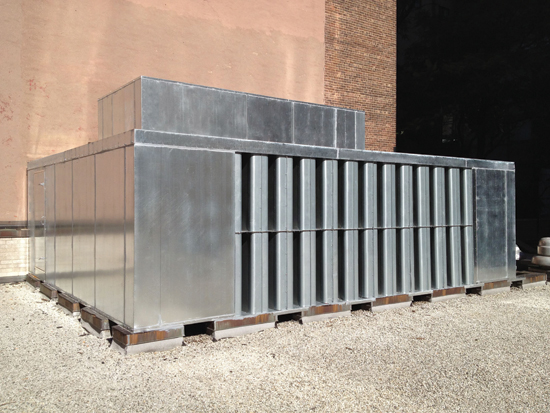Silence Is Golden
The invisible challenge: Optimizing the acoustic environment
![]() Continuing Education
Continuing Education
Use the following learning objectives to focus your study while reading this month’s Continuing Education article.
Learning Objectives - After reading this article, you will be able to:
- Discuss the effects of unwanted noise on human productivity and wellness.
- Describe acoustical metrics that directly impact building occupants and influence the value of a space.
- Compare key methods of reducing noise in the built environment in terms of effectiveness and ease of implementation.
- Explain the importance of, and methods for, increasing speech privacy and intelligibility in offices and educational environments.
As building systems continue to evolve, noise remains the same—acceptable or annoying. The former often goes unnoticed and the latter requires attention. Noise is the number one occupant complaint in many projects. Various research indicates that hospital patients complain about noise more than anything else. For those who travel, it should come as no surprise that noise is the biggest complaint among hotel guests. Even in restaurants, noise was the number one complaint in Zagat's latest national dining survey. Various studies indicate that noise can negatively impact occupants by ultimately lowering productivity and increasing stress levels. This “invisible” problem is loud and clear.
While building systems may change, noise is a constant condition that is best addressed during the design process. Unfortunately, this is not always the case and noise is often addressed in the final design stages or after customers move in and the complaints start. Solutions to most “noise problems” typically require the examination of multiple paths, and how they interact with each other and relevant building systems. By properly addressing all noise sources, offices can become more productive, conference room meetings more effective, and hospital patients more comfortable. A firm grasp of the basics can go a long way towards achieving spaces that allow occupants to maximize the intended use, whether it be sleeping, working, learning, or eating.
Acoustical Characteristics
There are several acoustical characteristics that occupants typically notice when entering a space. The first is often background noise, that is, how loud or quiet a space is. Another is how reverberant a space is. When there are surrounding occupied spaces, the noise isolation (or lack thereof) provided by building assemblies can become apparent. While these metrics can directly impact the occupants, they can also influence the decision to rent or buy a building or space. Class A office space, for example, typically achieves lower background noise levels than Class B or C, which is one reason why it commands a higher price per square foot. Integrating acoustics into the client dialogue early helps optimize the design process and end result for everyone involved.
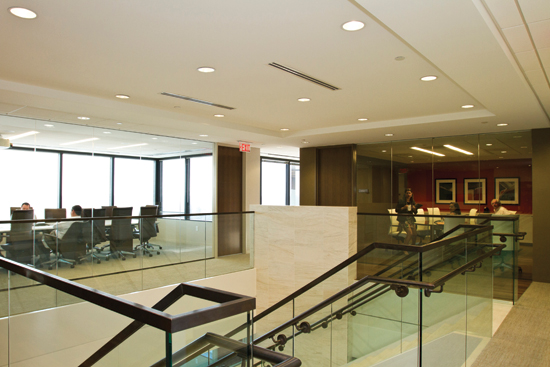
Photo courtesy of Price Industries
Properly addressing all noise sources allows building occupants to be more comfortable and productive.
Three Aspects of Noise
Noise can be thought of in three distinct aspects—source, path, and receiver. Every project has these three aspects, though they vary in number (one source vs. many) and importance (the receiver is an intern vs. the CEO). In many cases, noise control products can be applied to improve various conditions. Each project is unique with varying limitations such as budget or space. Understanding project parameters and available noise control products allows for the most effective design solution. The illustration above depicts some common noise conditions in a typical office setting and products to address them. Blue arrows indicate air flow and yellow waves indicate noise. The noise control products in yellow are often referred to as air transfer silencers and are discussed later.
Sound Transmission
Idealized lab-rated sound transmission loss is often described using STC (Sound Transmission Class), a lab measurement of the noise reduction provided by a building assembly. Examples of typical building assemblies with STC ratings include walls, ceiling, and floors. Other sound transmission field measurements are ASTC (Apparent Sound Transmission Class) and NIC (Noise Isolation Class) depending on field conditions. These field measured ratings are typically five points lower than the corresponding lab rating because of flanking paths such as cracks and holes (piping penetrations, mullion conditions, etc). The table below simplifies the description for common noise change perception, whether from a sound source or building assembly's noise isolation performance. To be clear, STC points and dB are not equivalent, but for the sake of simplicity and perception they are used interchangeably in this discussion.

Image courtesy of Price Industries
Noise control products address various conditions.
Field construction quality impacts drywall partition performance; often the joints are not properly finished, which decreases overall noise isolation. Over time, a partition's noise isolation performance may deteriorate. For example, if the caulk sealing a joint dries out, cracks can allow for noise to flank between spaces. Common elements such as light switches and electrical outlets also reduce noise isolation performance, since they're not always sealed completely and the plastic assemblies have lower mass than the drywall that was removed. Ultimately, field noise isolation provided by poor construction can vary from equivalent laboratory STC by more than 15. Operable partitions are even worse when comparing lab and field noise isolation ratings; the spread is often in excess of 10 due to flanking paths, improper installation, and operable wall size.
Several guidelines to optimize a wall construction's acoustic performance in the field include using two layers of overlapping drywall on each side of the stud between noise-sensitive spaces, selecting lighter-gauge metal channel studs, staggering electrical outlets and switches so they are not in the same stud space, filling stud cavities with sound-absorbing material, and sealing all joints and penetrations completely using non-hardening caulk. Just adding 2 inches of sound-absorbing material in a stud cavity for example can improve STC performance by at least 2 to 5 depending on the overall wall construction. One of the easiest methods to identify noise leaks is to perform a light test. Turn the lights off on one side of a building assembly and look for light leaking in on the dark side. Wherever there is light, there is the potential for noise to leak. Unfortunately if you're afraid of the dark, this is a horrible method.

Source: Price Industries
Noise Solutions
There are a variety of solutions on the market to decrease noise and increase building occupant satisfaction.
Acoustic Panels
While duct noise is usually addressed using silencers, radiated noise issues are not always caught due to a lack of communication and understanding among the different trades on a project. Acoustic panels can greatly reduce the transmission of radiated noise from rooftop units, generators, and internal mechanical equipment, and also reduce noise inside mechanical rooms because of their sound absorption properties. When used to fabricate large air plenums, acoustic panels have several advantages over drywall. Acoustic panels are less susceptible to moisture, can be easily cleaned, and provide equipment noise reduction because of the perforated liner much like a silencer. Drywall, on the other hand, often increases equipment noise due to its high reflectivity. In addition, drywall does not handle moisture very well, is not as durable as an acoustic panel, and is prone to more field installation variability as described earlier.
Acoustic panels are an engineered product available in various thicknesses utilizing a sandwich construction with various internal absorptive media options. Fiberglass insulation is the most common media, but they can also use foam, natural fibers, or mineral wool, depending on the application. Acoustic panels are manufactured in a controlled environment and final assembly occurs on the project site, so there is reduced variation in assembly performance. Insulated tongue-and-groove joints reduce possible flanking that could occur with traditional H-channel or non-insulated joints. Many projects utilize field-fabricated panels built by sheet metal contractors. Drawbacks of these site-constructed panels include a lack of lab-rated performance data, reduced material and paint options, and decreased consistency across projects.
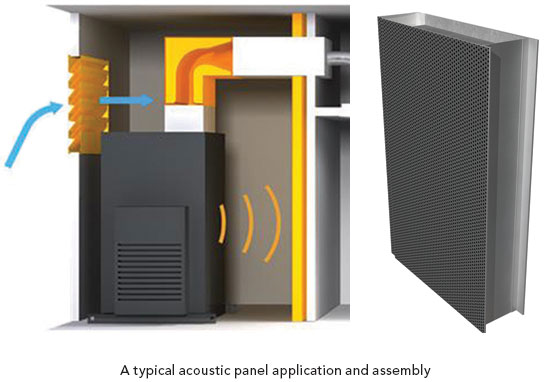
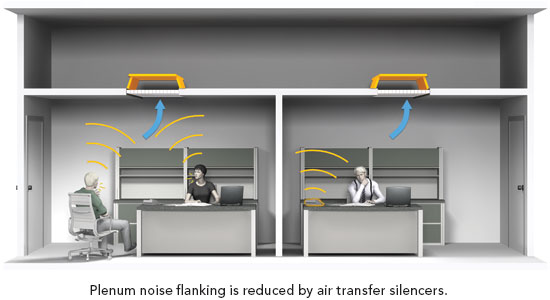
Images courtesy of Price Industries
Often used as noise barriers outside or to surround noisy equipment such as generators, acoustic panels typically consist of a solid casing side and perforated liner side. The perforated side typically faces the noise source because it is highly effective at absorbing sound. Acoustic panels can also improve partition and slab noise isolation performance (STC) by being placed between a noise source and existing building assembly. This is effective for targeted noise treatment. For example, if there were a conference room directly above a mechanical floor or equipment, acoustic panels could be installed in the mechanical room below the conference room to provide additional noise isolation performance for the overall slab assembly. Other alternatives like moving the equipment or adding mass to the slab are not always viable options.
Air Transfer Silencers
Air transfer silencers can provide additional noise reduction to ensure that overall partition assemblies provide adequate noise isolation or speech privacy. For example, two adjacent rooms separated by a non-full height wall can be negatively impacted by noise flanking through the common ceiling plenum. As depicted in the accompanying illustration, this noise path can be reduced by using air transfer silencers at return grilles with the added benefit of reducing visibility into the plenum space. Projects often utilize non-full height walls between private spaces as a way to reduce cost. Unfortunately, if the resulting flanking path is not properly addressed, the relevant private space's effectiveness is also reduced.
Another common condition is when a full height wall (floor to deck) requires transfer air between spaces, but must maintain a specific STC rating. Mechanical room partitions, for example, are often designed to have a minimum STC-50 rating, but often also require penetrations for return air. One method for achieving both return air transfer and noise isolation requirements is to use a cross talk silencer, as depicted in the accompanying illustration. This product has lab-tested performance and can be sized appropriately to satisfy project design requirements.

Images courtesy of Price Industries
Noise and light transmission are additional issues that are often overlooked during the design process. By addressing both of these issues, air transfer silencers allow for more flexible space layouts and mechanical equipment placement. They also can result in significant construction cost savings because of their simplified installation. Lined return boots are often recommended, but they have several drawbacks. For one, lined return boots are usually field fabricated with no reliable performance data. They also require additional labor due to support requirements and their height often limits installation especially in crowded or shallow plenum conditions. An air transfer silencer on the other hand can be installed directly below mechanical equipment in addition to having lab performance and minimal labor costs.

Noise and light flanking reduction using an air transfer silencer
It's important to clarify that air transfer silencers do not provide the same amount of noise reduction as HVAC-duct silencers. Rather, air transfer silencers allow for the overall STC or CAC (Ceiling Attenuation Class) to be preserved. Most ceiling tile manufacturers provide CAC ratings for suspended ceiling systems. CAC measures the noise reduction between two adjacent rooms by accounting for the sound path through the ceiling and common overhead plenum. The purpose of air transfer silencers is to ensure that any air transfer openings are not noise flanking paths—this is often the weak link that reduces noise isolation performance. This noise reduction is also relevant for air moving equipment radiated noise, such as fan coils, terminals, and exhaust fans. Because air transfer silencers provide more noise reduction than typical ceiling tile, they eliminate any noise flanking path that would otherwise create a hot spot in the occupied space directly below.
Acoustic Louvers
Acoustic louvers provide another method for reducing noise transmission in applications with limited space. Available in depths between 6 inches and 12 inches, acoustic louvers provide reasonable lab-rated noise attenuation while allowing for air flow between spaces, such as mechanical rooms and the outdoors. Acoustic louvers can be designed to satisfy façade aesthetic requirements including size, color, and material. The main variable to consider is air flow. Unlike a typical architectural louver that has around 45 to 50 percent free open area, acoustic louvers have around 25 to 30 percent free open area and, as such, have reduced air flow capacity. Proper coordination with the mechanical engineer typically allows for the inclusion of acoustic louvers and in many cases can free up additional mechanical room space because of their compact design.
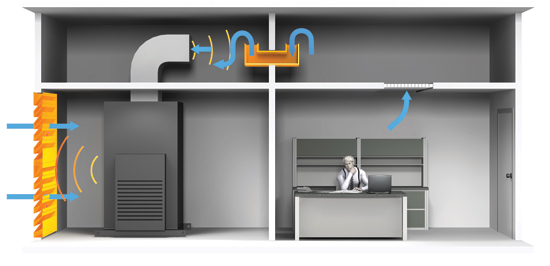
Acoustic louvers reduce noise transmission while satisfying air flow and limited space requirements.
Background Noise
Background noise is often described using noise criteria (NC) curves, a series of octave-band curves defining acceptable sound pressure levels from 63 to 8,000 Hz. It is best to measure NC levels at occupant ear height at the loudest location in a space during ambient conditions. Background noise is typically governed by mechanical equipment and industry guidelines of acceptable levels as outlined by various organizations including ASHRAE (HVAC Applications 48.3).
Background noise guidelines are provided in the accompanying table. There is no universal agreement on background noise levels for each space because each project and customer is unique. Rather, the table presents a starting point to then adjust as appropriate. For reference, hearing-impaired occupants typically require NC curves that are at least 5 points below the criteria presented in the table.
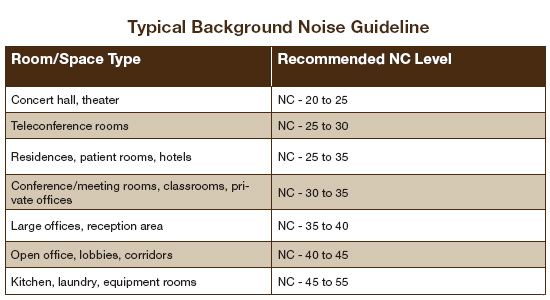
Source: Price Industries
Another common method for describing continuous noise levels is to use the room criteria (RC) rating system, which provides additional background noise qualitative descriptions, such as hissy and rumbly. RC is more appropriate to diagnose mechanical noise, though it has increased in usage over the years especially among acoustical consultants.
Design guidelines do not always align with the realities of project conditions. Sometimes, well intentioned design criteria are too stringent and it is more important to align customer expectations with space shortcomings and usage. These discussions should take place early in the design process once the proposed space and needs are understood. For example, if the customer's current conference rooms have background noise levels of NC-40 that work to user satisfaction, it might not be necessary to achieve NC-25/30 in a new space. Generally, lower background noise levels correspond to higher project costs. In addition, the customer might actually be more satisfied with NC-35/40 and find NC-25/30 to be too quiet. Ultimately, customer needs should always trump what a generalized table indicates.
Duct Silencers
These products can help achieve specific background noise levels within occupied spaces. Duct silencers typically consist of perforated metal baffles that absorb noise. They come in various shapes (rectangular, elbows, circular, etc) and sizes, typically starting at 24 inches in length. Commercial applications typically utilize silencers with fiberglass-filled baffles, though some school and healthcare projects require that no fibrous media be exposed to the airstream. In these applications, either film-lined or packless silencers are used. Film-lined silencers have a polymer film between the acoustic media and airstream, which ensures that no fibrous media can enter the airstream. Packless silencers do not have acoustic media and instead employ tuned chambers to absorb noise. They are especially useful for airstreams with corrosive contaminants and high heat applications, and are often used for lab and industrial projects.
A general rule is to not place mechanical equipment adjacent to occupied space especially when noise levels of NC-40 and below are required. Today there are air moving devices that utilize integrated silencers with lab tested total assembly performance to ensure that sound sensitive spaces are not negatively impacted by their operation. These unique products should not be confused with typical air moving devices paired with a silencer, since system effects and generated noise are not properly accounted for and often result in elevated noise levels and reductions in energy efficiency.
Speech Privacy
Today's office has changed a great deal from 50 years ago. These days, open design concepts are commonplace and have often resulted in dissatisfied occupants. Many research findings and surveys support the various failures of open office design including reduced productivity. Research published in the British Journal of Psychology found that office workers were 66 percent less productive in an open-plan office than when left on their own.1 It should be no surprise that noise is the number one complaint with open office design and this is largely driven by the reduction in privacy, when compared to an office with walls. However well intentioned these open office formats are, the end result is clear—speech privacy has suffered greatly in today's open office world and is likely to continue for some time. Understanding the impact that office design has on speech privacy is important so that the client not only appreciates the aesthetics, but also how a space sounds.
The three aspects of noise discussed earlier apply to speech privacy as well—the source (talker), path (distance), and receiver (listener / unhappy worker). Speech intelligibility is often described using the Articulation Index (AI), which describes subjective speech intelligibility between a source (talker) and receiver (listener). AI varies between 0 (complete privacy) and 1 (no privacy). AI is inversely related to speech privacy—that is, low intelligibility means high privacy. Speech privacy in open plan offices is difficult to achieve because of the direct paths between occupants and raised occupant noise levels that often occur. In spaces where clear communication is crucial such as boardrooms and auditoriums, a high AI is desired. The accompanying table lists AI values and corresponding intelligibility and privacy descriptions for reference.
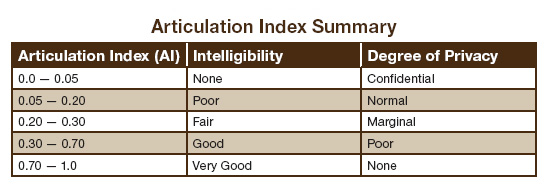
Source: Price Industries
Enclosed spaces typically have higher speech privacy than open spaces. The path's (walls, ceiling, doors, etc) ability to reduce noise transmission is typically limited by cracks and holes as described earlier. The total speech privacy between two enclosed spaces can be simply determined by adding background noise (NC) in the receiving space and field-measured acoustic separation (ASTC or NIC) between the two spaces.
Speech privacy between enclosed spaces illustrates the compromise between maintaining a low background noise level and the noise isolation required to achieve acceptable speech privacy. For example, conference rooms typically require low background noise levels (NC-25/30) and high speech privacy (SP 75+), which requires them to utilize higher noise isolation assemblies (STC-55+).
Sound Masking
One method of increasing speech privacy in open spaces is sound masking. It typically consists of speakers that produce a masking noise spectrum placed in the ceiling space. By raising the background noise level (NC), the speech privacy is increased. It is important to point out that privacy is increased over long distances (twenty feet or more), but not over short distances. That is to say, your noisy neighbor will still be noisy even with sound masking. Another common misperception is to use sound masking in private office and conference room spaces. This is often not needed, since walls should be designed to provide sufficient noise isolation. A single individual does not need speakers to increase privacy within an enclosed space since the walls do this. In a conference room, sound masking can have a negative effect by making it more difficult to understand individuals and interfering with audiovisual equipment. If used, it's worth discussing with the client and acoustical consultant so that expectations are aligned with the realities of sound masking.
Sound Absorption
Reverberation time indicates the amount of time for sound in a space to decay by 60 dB. In laymen's terms, it is the time needed for a sound to no longer be audible and is best measured in quiet environments without active mechanical equipment or other transient noise. Reverberation time should be tied to a space's intended function and often described at 500Hz. It is affected by the size of a room and the amount of absorption in a room. For example, learning spaces typically require shorter reverberation times (around 0.5 seconds) to allow for better speech intelligibility. Performance venues meanwhile typically require longer reverberation times (around 1.5 seconds), which result in spaces that sound richer and more full-bodied. One way to impact a space's reverberation time is by selecting surface treatments based on their sound absorption performance. An easy rule to remember is that by doubling the total amount of absorption in a room, the reverberation time is cut in half.
A material's ability to absorb noise is described in terms of its absorption coefficient, or α. A value of 0 indicates no absorption (complete reflection) and a value of 1 indicates complete absorption (no reflection). These coefficient values are typically determined using reverberation chambers by comparing the sound decay with and without the absorptive material in question. A common term used to describe a material's absorption performance is the noise reduction coefficient (NRC). The NRC is the arithmetic average of the sound absorption coefficients at 250, 500, 1000, and 2000Hz. This single number rating is rounded to the nearest multiple of 0.05 and is limited to describing mid-frequency absorption performance. Materials with NRC ratings above 0.5 are typically considered sound-absorbing, while materials with NRC ratings below 0.2 are considered sound-reflecting. The table lists NRC values for some common building materials and natural elements.
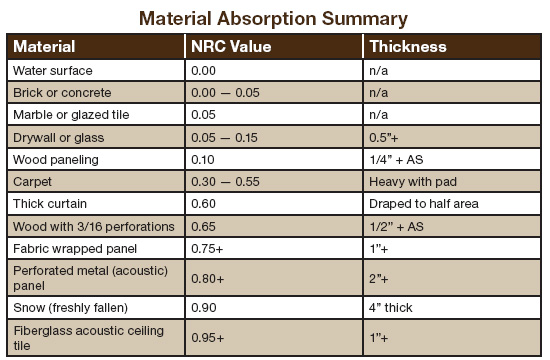
Source: Price Industries
It is worth mentioning that while acoustic ceiling tile (ACT) has a high NRC value, this is because the noise passes through (transmitted) and is captured in the space behind. An acoustic panel meanwhile can achieve NRC values that are just as high, but it does not allow noise to pass through because there is a solid outer casing as well. The important take away is that sound absorption (NRC) and noise isolation (STC) are not the same thing. Sound absorption is actually a combination of absorbed and transmitted energy, which can be a bit misleading for conditions where a large portion of the “absorption” is actually just transmitted energy. For example, an open window has a sound absorption coefficient of 1.0 because none of the noise is reflected back, but in reality the noise is all being transmitted and not actually absorbed. Noise isolation meanwhile describes how much sound is stopped. So it is common for many materials with high NRC values (absorption) to have very low noise isolation (STC) values. This is why it is best to use fiberglass ceiling tiles in open office spaces and mineral fiber tiles in private offices especially when offices do not have full height walls. The mineral fiber tiles reduce noise flanking through the plenum space because of their higher CAC values. The fiberglass tiles meanwhile “absorb” more noise and help improve speech privacy over longer distances in open office environments.
Another common sound absorption rating system used in Europe is the weighted sound absorption coefficient, αw, measured in accordance with EN ISO 11654. Absorption values vary between 0.00 and 1.00, but are only expressed in increments of 0.05. This system uses fixed reference curves from 125 to 4,000Hz and is similar to NRC except that it assigns “classes” to each absorption value range as listed in the following table.
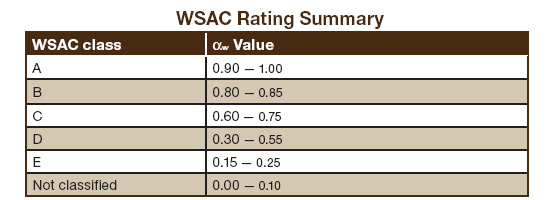
Source: Price Industries
The advantages of single number absorption rating systems is that materials can be quickly classified and compared with each other. The shortcoming is that these systems only account for a limited frequency range and do not allow for frequency-specific comparisons. As such, care should be taken when using the above absorption ratings and acoustical consultants should always be involved on more noise-sensitive projects.
General rules of thumb for achieving acceptable absorption can be dangerous, since each space is different both in usage and geometry. Because room absorption is directly impacted by surface area, an absorptive ceiling (NRC ≥0.80+) can provide much needed sound absorption and reduce reverberant noise levels by 10 dB. Walls are another good surface to treat, though modern construction often results in one or more being glass. Assuming it is thick enough, carpet can also provide sound absorption. Besides the thickness issue, another limitation of carpet is its distance and orientation from the occupants. Unless occupants are hiding under the table, much of the sound absorption provided by carpet is limited by the typical large conference room table, which is usually a hard, reflective surface. Increasing a room's size results in higher reverberation time and can increase speech intelligibility issues. This is why large classrooms, for example, must employ multiple absorptive surfaces to ensure that speech is not garbled by elevated reverberation levels. Utilizing acoustic ceiling tile, thicker carpet, and acoustic panels on at least two non-parallel wall surfaces are all methods for achieving a suitable reverberation time. Open office sound absorption is very straightforward: treat the entire ceiling with acoustic ceiling tile having a minimum NRC of 0.80. Carpet and absorptive cubical walls help, but remember the importance of maximizing absorptive surface area and occupant orientation. For example, speech levels at the front of a speaking person are around 10 dB louder than at their rear.
Acoustics and LEED
The specifics seem to constantly change, but currently both school and healthcare projects have several acoustical requirements and/or credits. LEED 2009 for Schools requires Minimum Acoustical Performance (IEQp3) based on background noise levels (≤45 dBA) and surface absorption in classrooms and core learning spaces depending on room size (20,000 cubic feet is the cutoff). LEED documentation recommends using acoustical ceiling tile to achieve required sound absorption performance (NRC ≥0.70). Not surprisingly, classrooms have many of the same issues as open offices discussed earlier. A German study2 found that 65 dBA is the average noise level in a classroom—a threshold level for possible noise-induced heart-attacks. It can be argued that this level of stress is totally unnecessary particularly when reducing reverberation time in a classroom is a relatively simple and inexpensive fix. Enhanced Acoustical Performance (IEQc9) is worth 1 point and requires both lower background noise levels (≤40 dBA) and minimum sound transmission performance (≥STC 35). For reference, these background noise and sound transmission requirements are less stringent than what most acoustical consultants and industry guidelines recommend.
LEED 2009 for Healthcare provides credits in the way of Acoustic Environment (IEQc2) that is worth 1-2 points and encompasses sound isolation, background noise, surface finish absorption, and exterior noise levels. Again, many of these acoustic credits can be easily earned by simply achieving industry accepted design criteria and good building design. A knowledgeable acoustical consultant can help ensure the correct criteria are met.
In the past few years, post-occupancy evaluation research from the Center for the Built Environment have identified acoustics as having the lowest occupant satisfaction ratings in both green and non-green buildings. Equally important is the fact that occupant satisfaction with acoustics actually decreased with the move from non-green to green buildings. Other IEQ metrics including lighting, office layout, and office furnishings were higher for green-buildings. In other words, acoustics are the biggest occupant complaint in green buildings. This should come as no surprise, since many of the methods employed by LEED have the added effect of reducing speech privacy, noise isolation, and/or sound absorption. For example, typical open office design often results in complaints of reduced speech privacy between occupants. Using large quantities of glass can increase natural light, but glass is also a very acoustically reflective material and typically provides lower sound isolation from outdoor noise. These are just a few examples of why LEED buildings are often plagued by low occupant satisfaction when it comes to acoustics.
A Holistic Approach to Noise Problems
Solutions to most “noise problems” typically require the holistic evaluation of multiple paths with each requiring individual attention. By properly addressing noise issues, offices are more productive, conference room meetings are more effective, and hospital patients are more comfortable. All of the design criteria and terms described above may not be directly relevant for every job, but each should be considered. Doing so will improve the end result, and provide more opportunity for project team integration throughout the building process. Most importantly, clients will be confident that all of their noise control concerns, not just the “usual suspects,” are addressed prior to construction. It is important for architects to play an active role especially in areas where there is no clear owner. In many cases, this “gray area” occurs at mechanical and air distribution equipment “in” the occupied space, such as terminals and diffusers. While engineers typically select the equipment, architects drive space planning and are ultimately held accountable for proper noise levels (since they often hire the acoustical consultant). Success is achieved when acoustics are prioritized. Clear communication between project team members on the desired acoustic environment and various available options lead to exceeding client expectations.
ENDNOTES
1. Banbury, S. and Berry, D. C. (1998), Disruption of office-related tasks by speech and office noise. British Journal of Psychology, 89: 499–517. doi: 10.1111/j.2044-8295.1998.tb02699.x
2. Ising H, Kruppa B. Health effects caused by noise: Evidence in the literature from the past 25 years. Noise Health 2004;6:5-13
 |
Price Industries is the leading manufacturer of air distribution products in the North American market, and works to bring about the vision of the design community by collaborating on high-quality, high-performing, and
customizable air distribution solutions. |

